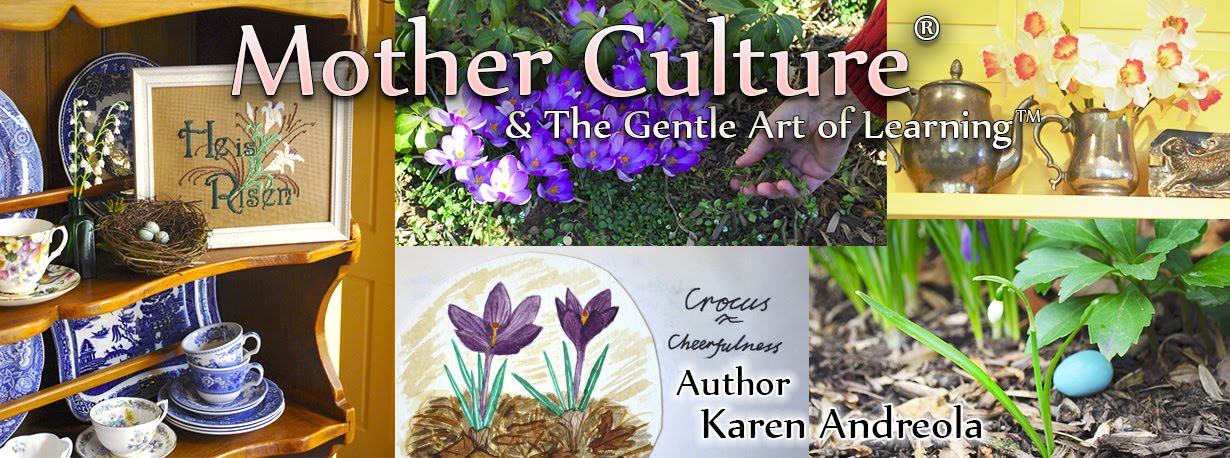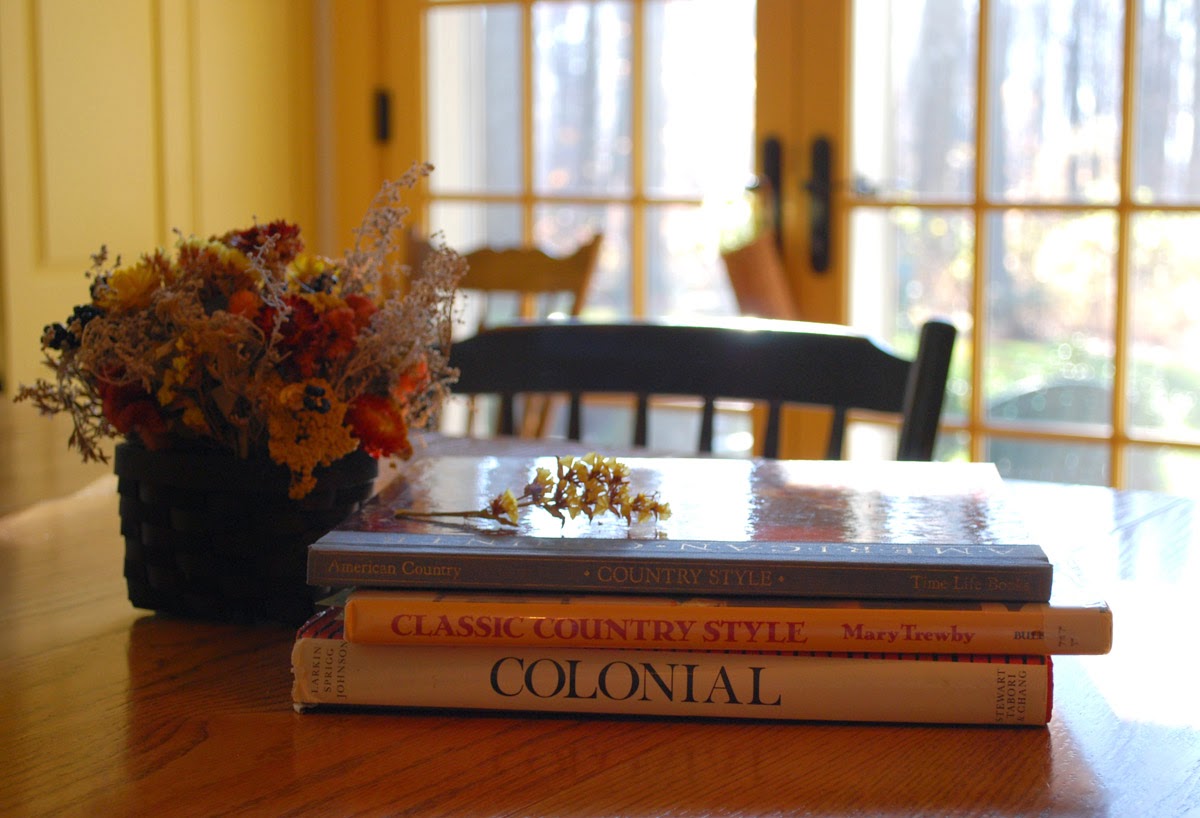"Not for years had she sat like this with another girl in the firelight and talked over the dear trivialities that make up the warmth of life." Chap. 18 Pilgrim Inn Elizabeth Goudge
We were surprised to see a little flock of bluebirds through the kitchen window. What a rare treat. They alighted on the sumac seeds. They must have been very hungry as I think they greatly prefer creepy crawly things.
By a sudden quirk of holiday humor I decided to place blue Christmas tree bulbs in a bowl on the cupboard. I believe our visiting bluebirds are to blame for this impulse.
A thrift store find also made its way into my decorating. Standing in the shop, the first reaction I had upon seeing it, was to identify with the hours that had gone into stitching it. I paid the embarrassing low price and took it home. Later, as I was falling asleep, pleasant thoughts of what to do with this pillow cover were like visions of sugar-plums dancing in my head.
Hmm, it has plenty of red and green for the Christmas season, I thought. But something bothered me about it. It was the border. I didn't care for it, I realized. The blue squares seemed to be a design flaw. I can cut it away, was my conclusion. I'll make it round and add red pipping. It was quite some time before I got around to washing the dust of years out of it, cutting it up and sewing it up.
Just as I put my hand to my anticipated task, tracing a circle onto it, I got a telephone call. It made me tremble. My 3 year-old grandson fell. He crushed a finger. His mother drove him to the hospital emergency. "Please pray that he won't lose the tip of his finger," I was asked, "The doctor warned of the possibility."
"Yes," I said shakily. I sewed and prayed. After surgery and nine hours later, he was home with a brightly colored bandage around his saved finger. "He's doing fine," was the call I had hoped for. Mom and Dad were exhausted. His aunt (my other daughter) took over by reading him bedtime stories. The Christmas rose pillow will probably always bring to my mind our answered prayer.
A Story at Christmastime
Early in December I ordered a short story from Amazon, I Saw Three Ships by Elizabeth Goudge. My name was put on a waiting list. It took a week for the book to come. When it did I read all 60 pages in one evening. Although most of the days this month have been heavily clouded and gray, the story brightened my soul. Now I'm reading it aloud to someone I love.The black and white illustrations by Margot Tomes are a style that fit the time period with precision. It's the late 18th century. Young Polly lives in England in a seacoast town with her two maiden aunts. Both Polly's parents die before the story starts but Polly seems to be adjusting fine in her new and different surroundings. She is more used to the country, however. And she longs for certain Christmas tradition that was followed as she remembers it - in the country. That is - keeping the doors of the house unlocked so that the Three Wise Men can visit. These were the years before the popularity of Father Christmas.
Polly stirs up hope and anticipation in her aunts who are rather set in their ways. And a bit anxious about their safety since their brother went away and their father died. They will not keep the doors unlocked on Christmas Eve. Absolutely not. They wouldn't want to tempt the undesirables from breaking-and-entering. Adamant, they tell Polly, "The only masculine protection in this house is your poor dear grandfather's Hat in the hall." The story made me smile. With its humor, yes, but also its demonstration of kindheartedness. The open window and the desire for unlocked doors in the story probably represent the characters' open minds and open hearts. And these are what permeate prayer, aren't they? Christmas is about miracles and long awaited answered prayer.
I've always been fond of the English carol and legend, I Saw Three Ships. The verses are cleverly woven into the plot of Elizabeth Goudge's touching story. My menfolk have been hearing this song around the house nearly every day, with this joyful jig recorded with flute, fiddle and piano. It is a song of rejoicing just as this story is one of rejoicing. Oh, I like happy endings, don't you? (For 4th grade to adult.)
Post Script of Dear Trivialities
There is a drummer boy, grown up and grown anciently old, in I Saw Three Ships. During my early years of married life I stitched a drummer boy ornament in crewel-wool from a kit. I got home from work before Dean did and remember clearly, sitting in a dark room, lit by one lamp and a single string of Christmas lights, head bent over my stitching while listening for his car in the drive. The the table mat under I Saw Three Ships is a crocheted gift from a caring blog reader. It happens to fit my tea table perfectly. Thank you.
I knit the mini-mitten in sock yarn on size one needles. It hangs on the feather tree.
You've probably already spotted on this blog, the child's well-worn antique shoes. I leave them out all year but somehow I like seeing them best among the Christmas greenery.
Blog friend, Lynne in Idaho, sent a photograph of her finished Lavender Strawberry Sachets. They turned out beautifully. I had forgotten the variety of fabric I had tucked in the kits in June. She would like to make Strawberry Sachets for gifts adding tiny glass beads. Thank you, Lynne, for sharing your photo. My readers are invited to share theirs.
Help Wanted
My daughter, Sophia, is in desperate need of a part time nanny. She is pregnant and struggling with back pain (an old car accident). She is grateful for the help of family and the small church she attends. But not wishing to impose, she is seeking help by way of a paying position. She homeschools her energetic boys age 3 and 7. If you know of anyone who lives in the Frederick-Mt.Airy area of Maryland, that can assist her around the house, please telephone me between 9am & 8pm. (If we don't pick up, please leave a voice mail with your name & phone number.)Our home business number is 717-786-6954.
Or email: karenjandreola@gmail.com. Thank you dearly.
Every Christmas Blessing be Yours,
























































